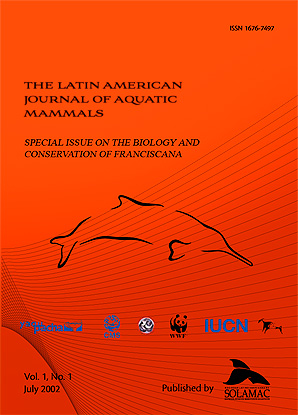Movement patterns of franciscana dolphins <i>(Pontoporia blainvillei)</i> in Bahia Anegada, Buenos Aires, Argentina
DOI:
https://doi.org/10.5597/lajam00011Abstract
From January 1993 to July 1999, systematic sightings of franciscana dolphins were conducted from four shore-based stations in Bahia Anegada, Argentina. Data were recorded using focal animal/group sampling methods. This study tested the hypothesis that dolphin movements within Bahia Anegada were random, assuming independence of sightings. The trend in dolphin swimming movement was defined as a direction scored as 'coming in', 'neutral', and 'going out'. In total 338 sightings were recorded, with a total effort of 2674 hours. The relative frequency of franciscana sightings demonstrated that movement was significantly dependent on tidal state, rejecting the hypothesis that dolphin swimming directions within the study area are random. Significant associations were also observed in the relative frequency of sightings in relation to the shore-based stations, suggesting a differential use of the bay's habitats perhaps due to location of prey, tidal current speed, depth, and topography of the coast.Downloads
How to Cite
Bordino, P. (2002). Movement patterns of franciscana dolphins <i>(Pontoporia blainvillei)</i> in Bahia Anegada, Buenos Aires, Argentina. Latin American Journal of Aquatic Mammals, 1(1), 71-76. https://doi.org/10.5597/lajam00011
Issue
Section
Articles
License
Authors who publish with this journal agree to the following terms:- Authors retain copyright and grant the journal right of first publication with the work simultaneously licensed under a Creative Commons Attribution License that allows others to share the work with an acknowledgement of the work's authorship and initial publication in this journal.
- Authors are able to enter into separate, additional contractual arrangements for the non-exclusive distribution of the journal's published version of the work (e.g., post it to an institutional repository or publish it in a book), with an acknowledgement of its initial publication in this journal.
- Authors are permitted and encouraged to post their work online (e.g., in institutional repositories or on their website) prior to and during the submission process, as it can lead to productive exchanges, as well as earlier and greater citation of published work (See The Effect of Open Access).


